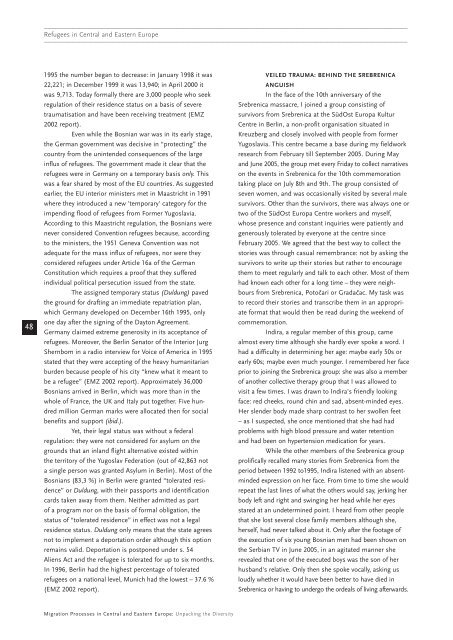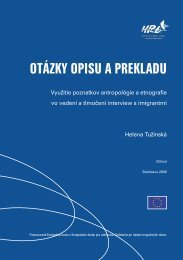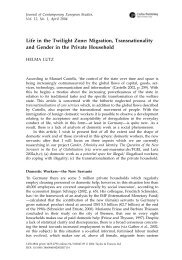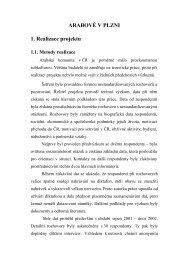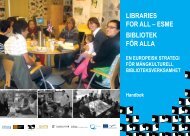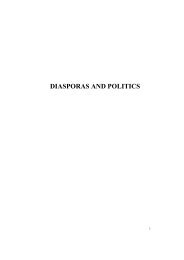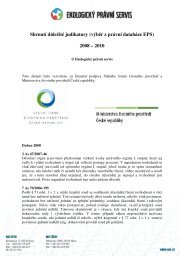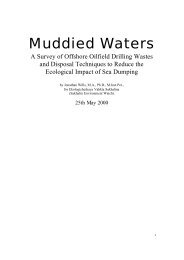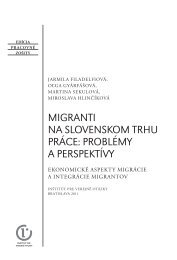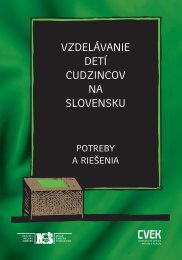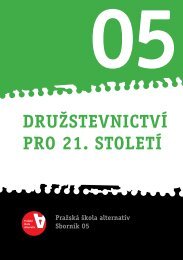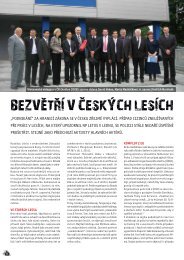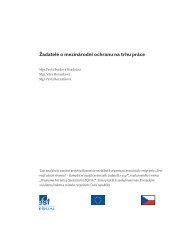Migration Processes in Central and Eastern Europe - Multiple Choices
Migration Processes in Central and Eastern Europe - Multiple Choices
Migration Processes in Central and Eastern Europe - Multiple Choices
Create successful ePaper yourself
Turn your PDF publications into a flip-book with our unique Google optimized e-Paper software.
———————————————————————————————————————————————————————————————<br />
Refugees <strong>in</strong> <strong>Central</strong> <strong>and</strong> <strong>Eastern</strong> <strong>Europe</strong><br />
———————————————————————————————————————————————————————————————<br />
48<br />
1995 the number began to decrease: <strong>in</strong> January 1998 it was<br />
22,221; <strong>in</strong> December 1999 it was 13,940; <strong>in</strong> April 2000 it<br />
was 9,713. Today formally there are 3,000 people who seek<br />
regulation of their residence status on a basis of severe<br />
traumatisation <strong>and</strong> have been receiv<strong>in</strong>g treatment (EMZ<br />
2002 report).<br />
Even while the Bosnian war was <strong>in</strong> its early stage,<br />
the German government was decisive <strong>in</strong> “protect<strong>in</strong>g” the<br />
country from the un<strong>in</strong>tended consequences of the large<br />
<strong>in</strong>flux of refugees. The government made it clear that the<br />
refugees were <strong>in</strong> Germany on a temporary basis only. This<br />
was a fear shared by most of the EU countries. As suggested<br />
earlier, the EU <strong>in</strong>terior m<strong>in</strong>isters met <strong>in</strong> Maastricht <strong>in</strong> 1991<br />
where they <strong>in</strong>troduced a new 'temporary' category for the<br />
impend<strong>in</strong>g flood of refugees from Former Yugoslavia.<br />
Accord<strong>in</strong>g to this Maastricht regulation, the Bosnians were<br />
never considered Convention refugees because, accord<strong>in</strong>g<br />
to the m<strong>in</strong>isters, the 1951 Geneva Convention was not<br />
adequate for the mass <strong>in</strong>flux of refugees, nor were they<br />
considered refugees under Article 16a of the German<br />
Constitution which requires a proof that they suffered<br />
<strong>in</strong>dividual political persecution issued from the state.<br />
The assigned temporary status (Duldung) paved<br />
the ground for draft<strong>in</strong>g an immediate repatriation plan,<br />
which Germany developed on December 16th 1995, only<br />
one day after the sign<strong>in</strong>g of the Dayton Agreement.<br />
Germany claimed extreme generosity <strong>in</strong> its acceptance of<br />
refugees. Moreover, the Berl<strong>in</strong> Senator of the Interior Jurg<br />
Shernbom <strong>in</strong> a radio <strong>in</strong>terview for Voice of America <strong>in</strong> 1995<br />
stated that they were accept<strong>in</strong>g of the heavy humanitarian<br />
burden because people of his city “knew what it meant to<br />
be a refugee” (EMZ 2002 report). Approximately 36,000<br />
Bosnians arrived <strong>in</strong> Berl<strong>in</strong>, which was more than <strong>in</strong> the<br />
whole of France, the UK <strong>and</strong> Italy put together. Five hundred<br />
million German marks were allocated then for social<br />
benefits <strong>and</strong> support (ibid.).<br />
Yet, their legal status was without a federal<br />
regulation: they were not considered for asylum on the<br />
grounds that an <strong>in</strong>l<strong>and</strong> flight alternative existed with<strong>in</strong><br />
the territory of the Yugoslav Federation (out of 42,863 not<br />
a s<strong>in</strong>gle person was granted Asylum <strong>in</strong> Berl<strong>in</strong>). Most of the<br />
Bosnians (83,3 %) <strong>in</strong> Berl<strong>in</strong> were granted “tolerated residence”<br />
or Duldung, with their passports <strong>and</strong> identification<br />
cards taken away from them. Neither admitted as part<br />
of a program nor on the basis of formal obligation, the<br />
status of “tolerated residence” <strong>in</strong> effect was not a legal<br />
residence status. Duldung only means that the state agrees<br />
not to implement a deportation order although this option<br />
rema<strong>in</strong>s valid. Deportation is postponed under s. 54<br />
Aliens Act <strong>and</strong> the refugee is tolerated for up to six months.<br />
In 1996, Berl<strong>in</strong> had the highest percentage of tolerated<br />
refugees on a national level, Munich had the lowest – 37.6 %<br />
(EMZ 2002 report).<br />
VEILED TRAUMA: BEHIND THE SREBRENICA<br />
ANGUISH<br />
In the face of the 10th anniversary of the<br />
Srebrenica massacre, I jo<strong>in</strong>ed a group consist<strong>in</strong>g of<br />
survivors from Srebrenica at the SüdOst Europa Kultur<br />
Centre <strong>in</strong> Berl<strong>in</strong>, a non-profit organisation situated <strong>in</strong><br />
Kreuzberg <strong>and</strong> closely <strong>in</strong>volved with people from former<br />
Yugoslavia. This centre became a base dur<strong>in</strong>g my fieldwork<br />
research from February till September 2005. Dur<strong>in</strong>g May<br />
<strong>and</strong> June 2005, the group met every Friday to collect narratives<br />
on the events <strong>in</strong> Srebrenica for the 10th commemoration<br />
tak<strong>in</strong>g place on July 8th <strong>and</strong> 9th. The group consisted of<br />
seven women, <strong>and</strong> was occasionally visited by several male<br />
survivors. Other than the survivors, there was always one or<br />
two of the SüdOst Europa Centre workers <strong>and</strong> myself,<br />
whose presence <strong>and</strong> constant <strong>in</strong>quiries were patiently <strong>and</strong><br />
generously tolerated by everyone at the centre s<strong>in</strong>ce<br />
February 2005. We agreed that the best way to collect the<br />
stories was through casual remembrance: not by ask<strong>in</strong>g the<br />
survivors to write up their stories but rather to encourage<br />
them to meet regularly <strong>and</strong> talk to each other. Most of them<br />
had known each other for a long time – they were neighbours<br />
from Srebrenica, Potočari or Gradačac. My task was<br />
to record their stories <strong>and</strong> transcribe them <strong>in</strong> an appropriate<br />
format that would then be read dur<strong>in</strong>g the weekend of<br />
commemoration.<br />
Indira, a regular member of this group, came<br />
almost every time although she hardly ever spoke a word. I<br />
had a difficulty <strong>in</strong> determ<strong>in</strong><strong>in</strong>g her age: maybe early 50s or<br />
early 60s; maybe even much younger. I remembered her face<br />
prior to jo<strong>in</strong><strong>in</strong>g the Srebrenica group: she was also a member<br />
of another collective therapy group that I was allowed to<br />
visit a few times. I was drawn to Indira's friendly look<strong>in</strong>g<br />
face: red cheeks, round ch<strong>in</strong> <strong>and</strong> sad, absent-m<strong>in</strong>ded eyes.<br />
Her slender body made sharp contrast to her swollen feet<br />
– as I suspected, she once mentioned that she had had<br />
problems with high blood pressure <strong>and</strong> water retention<br />
<strong>and</strong> had been on hypertension medication for years.<br />
While the other members of the Srebrenica group<br />
prolifically recalled many stories from Srebrenica from the<br />
period between 1992 to1995, Indira listened with an absentm<strong>in</strong>ded<br />
expression on her face. From time to time she would<br />
repeat the last l<strong>in</strong>es of what the others would say, jerk<strong>in</strong>g her<br />
body left <strong>and</strong> right <strong>and</strong> sw<strong>in</strong>g<strong>in</strong>g her head while her eyes<br />
stared at an undeterm<strong>in</strong>ed po<strong>in</strong>t. I heard from other people<br />
that she lost several close family members although she,<br />
herself, had never talked about it. Only after the footage of<br />
the execution of six young Bosnian men had been shown on<br />
the Serbian TV <strong>in</strong> June 2005, <strong>in</strong> an agitated manner she<br />
revealed that one of the executed boys was the son of her<br />
husb<strong>and</strong>'s relative. Only then she spoke vocally, ask<strong>in</strong>g us<br />
loudly whether it would have been better to have died <strong>in</strong><br />
Srebrenica or hav<strong>in</strong>g to undergo the ordeals of liv<strong>in</strong>g afterwards.<br />
<strong>Migration</strong> <strong>Processes</strong> <strong>in</strong> <strong>Central</strong> <strong>and</strong> <strong>Eastern</strong> <strong>Europe</strong>: Unpack<strong>in</strong>g the Diversity


